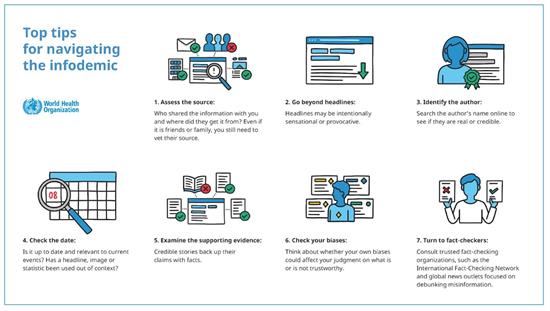There is a lot of COVID-19 vaccine information but not all of it is reliable. Here are tips to help you spot misinformation.
Last Updated: January 11, 2022
Information available in:
ASL
-
Information is something that is accurate to the best current knowledge. One of the difficulties with any new disease, like COVID-19, is that information changes over time as new science and knowledge emerge.
-
Misinformation, on the other hand, is incorrect. Many people believe they are sharing good information – but unfortunately, that is not always the case. Misinformation can be quite harmful even if that’s not the intention. When an issue has a lot of attention, and evidence changes quickly, information can quickly spiral into misinformation.
-
Disinformation is false information created with the intention of profiting from it or causing harm. Disinformation generally serves some agenda and can be dangerous.
Who shared the information with you and where did they get it from? Even if the information is from friends or family, you still need to assess their source.
To check for fake social media accounts, look at how long profiles have been active, their number of followers and their most recent posts. For websites, check the “About Us” and “Contact Us” pages to look for background information and legitimate contact details.
Other clues that a source may be unreliable or inaccurate include unprofessional visual design, poor spelling and grammar, or excessive use of all caps or exclamation points.
Headlines may be intentionally sensational or provocative to get a high number of readers. Make sure to read more than just the headline of an article –
go further and look at the entire story.
Search more widely than social media for information – look at print sources such as newspapers and magazines, and digital sources such as podcasts and online news sites. Diversifying your sources allows you to get a better picture of what is or is not trustworthy.
Search the author’s name online to see if they are real and/or credible. Check the URL, email address, or letterhead when you’re reading something from a new source.
Spam can look real, but often the URL or email address will give away that the source is untrustworthy.
When you come across information, ask yourself these questions:
- Is this a recent story?
- Is it up to date and relevant to current events?
- Has a headline, image or statistic been used out of context?
Credible stories back up claims with facts – for example, quotes from experts or links to statistics or studies.
Everyone has biases and these impact how people view what’s happening around them. Think about your own biases and why you may have been drawn to a particular headline or story.
Reflect: What is your understanding of it? Why did you react to it in that way? Does it challenge your assumptions, or tell you what you want to hear? What did you learn about yourself from your reaction?
When in doubt, consult trusted fact-checking organizations, such as the
International Fact-Checking Network and global news outlets focused on debunking misinformation and disinformation, including the Associated Press and Reuters. Look to Canadian sources like
Science Up First.

Scientists around the world are working hard to keep up with the thousands of studies that have come out since COVID-19 appeared. But not everyone gets their information just from scientific studies.
Public health and policy decision-makers look to a body of information when they develop guidance. One scientific study is not enough to shape policy – agreement on all of the most up-to-date information is required for decision-making.
You might be getting information from a bunch of different places. Not all of this information will be trustworthy and unbiased and might include:
- Official communications from governments and health agencies
- News articles and opinion pieces
- Messages from vloggers, bloggers, and podcasters
- Social media influencers
- Messages, posts from friends and family
- Direct communication with those around you
If you are struggling to communicate with people in your community who are hearing misinformation or disinformation check out this
resource on how to talk with them (PDF).
To help young people understand more about misinformation and how to learn to challenge it, go to
Kidsboostimmunity.ca.
Ask yourself these questions:
- How does this make me feel?
- Why am I sharing this?
- How do I know if it’s true?
- Where did it come from?
- Whose messaging am I supporting by sharing it?
If you know something is false, or if it makes you angry, don’t share it to debunk it or make fun of it. That just spreads the misinformation or disinformation further. Learn more about how you can report misinformation online.
This content has been adapted from the WHO under creative commons.
American Sign Language
